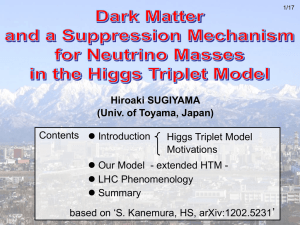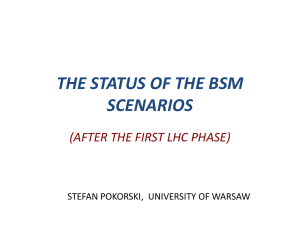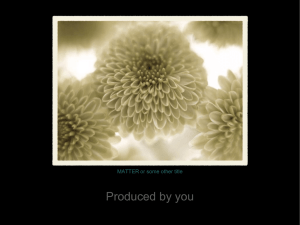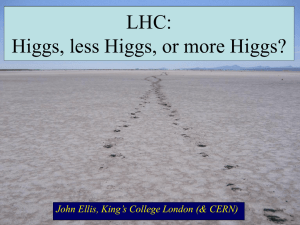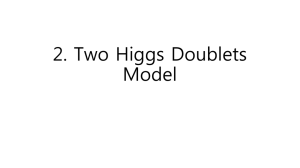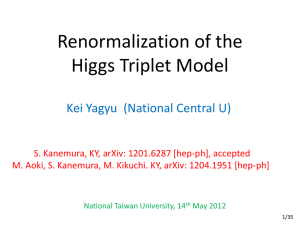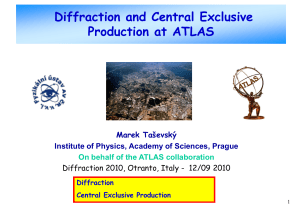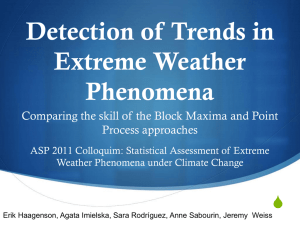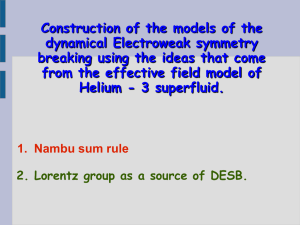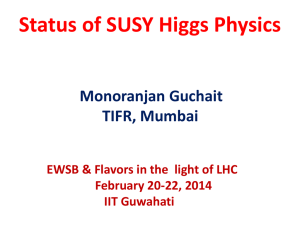LCWS2012_keiyagyu
advertisement
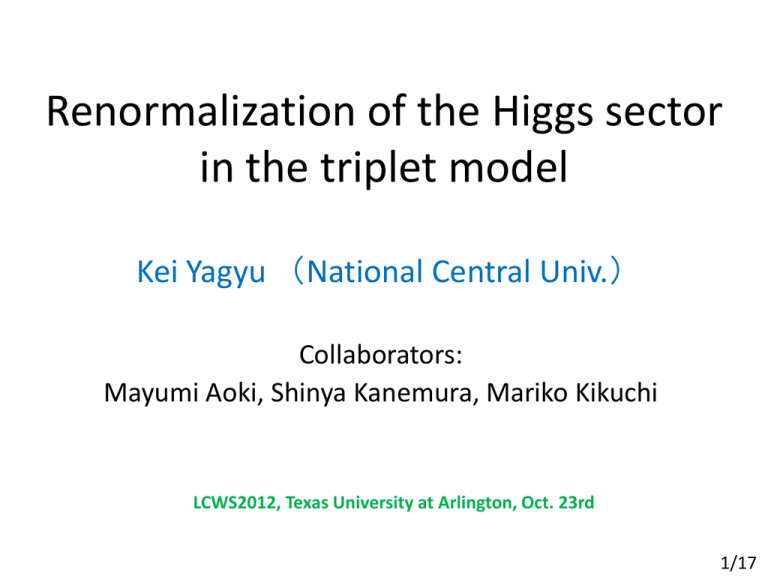
Renormalization of the Higgs sector in the triplet model Kei Yagyu (National Central Univ.) Collaborators: Mayumi Aoki, Shinya Kanemura, Mariko Kikuchi LCWS2012, Texas University at Arlington, Oct. 23rd 1/17 The Higgs Triplet Model The Higgs triplet field Δ is added to the SM. U(1)Y U(1)L Φ 2 1/2 0 Δ 3 1 -2 Cheng, Li (1980); Schechter, Valle, (1980); Magg, Wetterich, (1980); Mohapatra, Senjanovic, (1981). ・Neutrino Yukawa interaction: ・Higgs Potential: SU(2)I Lepton number breaking parameter ・Neutrino mass matrix MΔ : Mass of triplet scalar boson. vΔ : VEV of the triplet Higgs 2/17 The Higgs Triplet Model The Higgs triplet field Δ is added to the SM. U(1)Y U(1)L Φ 2 1/2 0 Δ 3 1 -2 Cheng, Li (1980); Schechter, Valle, (1980); Magg, Wetterich, (1980); Mohapatra, Senjanovic, (1981). ・Neutrino Yukawa interaction: ・Higgs Potential: SU(2)I Lepton number breaking parameter ・Neutrino mass matrix O(0.1) eV O(0.1) eV O(1) 246 GeV O(100) GeV The HTM can be tested at colliders !! 2/17 Important predictions ★ Rho parameter deviates from unity. ★ Extra Higgs bosons Doubly-charged H±±, Singly-charged H±, CP-odd A and CP-even Higgs boson H ★ Characteristic mass relation is predicted. mH++2 - mH+2 ≃ mH+2 - mA2 Under vΔ << vΦ (From experimental data ρexp ~ 1) Case I (λ5 > 0) Mass Φ Case II (λ5 < 0) Mass A, H H++ H+ H+ H++ A, H 3/17 Theoretical bounds ‣Vacuum stability bound (Bounded from below) lim r→∞ V (rv1, rv2, …, rvn) > 0 Arhrib, et al., PRD84, (2011) (4) λ2 = λ3 = λΔ ‣Perturbative unitarity bound Lee, Quigg, Thacker, PRD16, (1977) Aoki, Kanemura, PRD77, (2008); Arhrib, et al., PRD84, (2011) ji : Longitudinal modes of weak gauge bosons and physical Higgs bosons or 1 Eigenvalues of the matrix |xi| < 8π or 16π 4/17 Theoretical bounds Case for λ5 = 0 (Δm = 0 ) Allowed 5/17 1-loop corrected W mass Case I ξ = mH++2 – mH+2 mh = 126 GeV, mt = 173 GeV Mass A, H μ = 5 GeV H+ |ξ| = (200 GeV)2 H++ Case II Mass |ξ| = (100 GeV)2 H++ H+ |ξ| = 0 In the large mass limit, the HTM can be decoupled to the SM. A, H 6/17 1-loop corrected W mass Δm = mH++ – mH+ Case I mh = 126 GeV, mt = 173 GeV Mass A, H H+ H++ Case II Mass vΔ = 1 MeV H++ vΔ = 5 GeV H+ vΔ = 10 GeV A, H For large triplet VEV case, large mass difference is favored. 7/17 Testing the Higgs Triplet Model at colliders • Indirect way (Decoupling case) -Precise measurement for the Higgs couplings Ex. hγγ, hhh, hWW, hZZ, … • Direct way 126 GeV H++, H+, H, A h -Discovery of extra Higgs bosons Ex. Doubly-charged Higgs boson, Singly-charged Higgs boson, … - Testing the mass spectrum among the triplet like Higgs bosons. 8/17 Higgs → γγ Arhrib, et al. JHEP04 (2012); Kanemura, KY, PRD85 (2012); Akeroyd, Moretti PRD86 (2012) + SM contribution + Triplet-like Higgs loop contribution 𝜆ℎ𝐻 + 𝐻− ≈ −(𝜆4 + 𝜆5 /2)𝑣 If λ4 < 0 → Constructive contribution Sign of λ4 is quite important! If λ4 > 0 → Destructive contribution Signal strength (σobs/σSM) is 1.56± 0.43 (CMS) and 1.9±0.5 (ATLAS). Disallowed by vacuum stab. When triplet Higgs mass ~ 300 GeV, hγγ can be enhanced by ~ +40 % ~ +50% . 9/17 Renormalized hhh coupling h Tree = h 1PI + + Aoki, Kanemura, Kikuchi, KY, PLB714 (2012) Counter term h Corresponds to Δhγγ ~ +50 % When hγγ (HTM) > hγγ (SM) [λ4 <0], hhh (HTM) < hhh (SM). In the case of λ4 ~ -2, deviation of the hhh coupling is -10 ~ -60 %. 10/17 Renormalized hZZ and hWW coupling Z, W Tree = h 1PI + + Counter term Z, W hZZ hWW In the case of λ4 ~ -2, deviation of the hZZ (hWW) coupling is 0 ~ -0.5% (-0.1 ~ -0.7)%. 11/17 Testing the Higgs Triplet Model at colliders • Indirect way (Decoupling case) -Precise measurement for the Higgs couplings Ex. hγγ, hWW, hZZ, hhh, … • Direct way 126 GeV h H++, H+, H, A -Discovery of extra Higgs bosons Ex. Doubly-charged Higgs boson, Singly-charged Higgs boson, … - Testing the mass spectrum among the triplet like Higgs bosons. 12/17 Decay property of the triplet-like Higgs bosons [O(100) GeV case] Decay of H++ Δm Decay of H+ H+ W+ l+l+ 1 eV Decay of H or A 10 GeV vΔ νν l+ν H++ l+ Excluded @ LHC bb W+Z vΔ vΔ H++ l+ Δm H W+ W+ W+ 0.1 MeV Δm W+ W+ H+ H W+ b b H++ W+ Discussed by Chiang, Nomura, Tsumura, PRD85, 2012 13/17 Mass reconstruction at LHC Aoki, Kanemura, KY, PRD85(2012) qq’ → H++H- → (l+l+ννbb)(jjbb) qq’ → H+H → (l+νbb)(bb) H++ 140 GeV H+ 130 GeV 119 GeV 114 GeV H, A h qq → HA → (bb)(bb) MT, Minv MT MT Signal only mH++ 130 fb 42 fb 33 fb 12 fb 8.0 fb (14 TeV) 2.8 fb (7 TeV) mH+ mH, mA All the masses of the Δ-like scalar bosons may be reconstructed. 14/17 Decay property of the triplet-like Higgs bosons [O(100) GeV case] Decay of H++ Δm Decay of H+ H+ W+ l+l+ 1 eV W+ H++ H+ W+ Decay of H or A 10 GeV vΔ νν l+ν vΔ H vΔ H++ ν Challenging to detect at LHC H++ l+ Excluded @ LHC bb W+Z ν l+ Δm H W+ W+ W+ 0.1 MeV Δm W+ W+ H+ H W+ b b H++ W+ Discussed by Chiang, Nomura, Tsumura, PRD85, 2012 15/17 Mass reconstruction at ILC Root(s) mH+ = 200 GeV, mH = 170 GeV, Root(s) = 500 GeV, 100 fb-1 σ ~ 20 fb Ejjmin Ejjmax Dijet Energy Ejj Dijet Invariant mass Mjj Mjjmax H++ can be measured by looking at the excess of the SS dilepton + jets + missing event. 16/17 Summary ‣The Higgs Triplet Model (HTM): Tiny neutrino masses can be explained. ‣Indirect way to test the HTM at colliders (Decoupling case): Measuring the deviation of the Higgs coupling from the SM prediction. Ex) Triplet Higgs mass = 300 GeV case ・ hγγ → +50% Current LHC data can be reproduced. ・ hhh → -60 % ~ +100 % Direction of the correction is opposite to hγγ. ・ hZZ, hWW → ~-1 % O(1%) deviation of hVV can be measured at the ILC. ‣Direct way to test the HTM at colliders (Light triplet Higgs case): At the LHC, mH > mH+ > mH++ with small vΔ case is challenging to test the model. At the ILC, even if this scenario is realized, triplet-like Higgs bosons may be detectable by using the dijet energy and invariant mass distribution. ILC is necessary to test the HTM in both indirect way and direct way!! 17/17 Cross section Renormalization of the Higgs potential Aoki, Kanemura, Kikuchi, KY, PLB714 8 physical parameters 8 parameters in the potential μ , m , M , λ1 , λ2 , λ3 , λ4 , λ5 Counter terms v , mH++ , mH+ , mA , mh , mH , α, β’ (vΔ) δv , δmH++2 , δmH+2 , δmA2, δmh2 , δmH2 , δα, δβ’ Tadpole: δTφ , δTΔ , Wave function renormalization:δZH++, δZH+, δZA, δZH, δZh Reno. of EW parameters δv δTφ , δTΔ Vanishing 1-point function On-shell condition δmH++2 , δmH+2 , δmA2, δmH2 , δmh2 δZH++, δZH+, δZA, δZH, δZh No-mixing condition where 2-point function is defined by δα, δβ’ Constraints from EW precision data There are 3 parameters: g, g’ and v in the kinetic term of Higgs fields. The electroweak observables are described by the 3 input parameters. We can choose αem, mW and mZ as the 3 input parameters. The weak angle sin2θW = sW2 can be described in terms of the gauge boson masses. The counter term of δsW2 is derived as ~ δρ = ρ-1 = αem T The quantity δρ (or T) measures the violation of the custodial symmetry. Constraints from EW precision data There are 4 parameters (instead of 3 in the SM): g, g’, v and vΔ in the kinetic term of Higgs fields. The electroweak observables are described by the 4 input parameters. The weak angle sin2θW = sW2 cannot be given in terms of the gauge boson masses. Scheme 1 Blank, Hollik (1997) Input parameters: mW, mZ, αem, sW2 e Z e Chankowski, Pokorski, Scheme 2 Wagner (2007); Input parameters: Chen, Dawson, Jackson mW, mZ, αem, vΔ (2008) Additional renormalization condition Scheme 1 =0 1PI diagram Scheme 2 Counter term Diboson decay scenario Realizing vΔ > 0.1 MeV with Case I ‣Signal: Same-sign dilepton + Jets + Missing Chiang, Nomura, Tsumura, 2012 When mH++ = 100 GeV, root(s) = 7 TeV the signal cross section is ~ 3 fb. ‣Chiang, Nomura and Tsumura studied discovery potential for this scenario at the LHC. ‣Data: L~2 fb-1, root(s) = 7 TeV at ATLAS 6 events have been discovered, which is consistent with the SM prediction. Can we set a lower bound for the mass of H++ in the case of H++ decays into diboson? ATLAS, data 2011 Mass reconstruction at ILC Ex. mX+ = 200 GeV, mX0 = 70 GeV Experimental bounds (Direct) Assuming 100% same-sign leptonic decay of the doubly-charged Higgs boson CMS PAS HIG-12-005, 7TeV, 4.6 fb-1 mH++ >~ 400 GeV Dilepton decay scenario Realizing vΔ < 0.1 MeV with Case I. ‣By measuring the pattern of leptonic decay, we can direct test the neutrino mass matrix. li + BR H++ lj + Akeroyd, Aoki, Sugiyama, 2008 ∝ |hij|2 ‣Lepton flavor violation (μ → 3e, μ-e conversion, etc) heμ Chun, Lee, Park, 2003; Kakizaki, Ogura, Shima, 2003; Abada, Biggio, Bonnet, Gavela, Hambey, 2007, … hee ‣LHC phenomenology -4 lepton , 3 lepton signature Perez, Han, Huang, Li, 2008 ; Akeroyd, Chiang, Gaur, 2010, … Sugiyama, Tsumura, Yokoya, arXiv:1207.0179 -Using tau polarization Discrimination of chiral structure of the Yukawa coupling -Same sign tetra-lepton signature Chun, Sharma, arXiv:1206.6278 Experimental bounds (Indirect) Gauge boson self-energies 6 nondec. d.o.f. Model w/ ρtree = 1 3 input parameters → 6-3 (Ren. conditions) = 3 nondec. d.o.f. = S, T, U Peskin, Takeuchi, PRL65, (1990) = = = Model w/o ρtree = 1 4 input parameters Blank, Hollik, NPB514, (1998) → 6-4 (Ren. conditions) = 2 nondec. d.o.f. = 1-loop corrected W mass Kanemura, KY, PRD85 (2012)Case I Case II A, H H++ H+ H+ H++ A, H Radiative corrections to the mass spectrum Aoki, Kanemura, Kikuchi, KY, arXiv: 1204.1951 Ratio of the squared mass difference R Case I Tree level: Less than 10-3 Loop level: Loop correction (mA2)treeis determined by mH++2 and mH+2 : In favored parameter sets by EW precision data: mH++ = O(100)GeV, |Δm|~100GeV, ΔR can be as large as O(10)%. Custodial Symmetry The SM Lagrangian can be written by the 2×2 matrix form of the Higgs doublet: When we take g’ and yA → 0, Lagrangian is invariant under SU(2)L×SU(2)R ★ Kinetic term , After the Higgs field gets the VEV: ★ Higgs potential this symmetry is reduced to SU(2)L=SU(2)R =SU(2)V (custodial symmetry). ★ Yukawa interaction (top-bottom sector) SU(2)V breaking by g’ is included in the definition of the rho parameter, while that by yA is not. There is a significant contribution to the deviation of rho = 1 from the top-bottom sector by the loop effect. 1-loop corrected W mass Case I Mass ξ = mH++2 – mH+2 Scheme 1 Scheme 2 Case II Mass A, H H++ H+ H+ H++ A, H In Scheme II, decoupling limit can be taken in the heavy mass limit. Production mechanisms at LHC Main production process Drell-Yan - depends on the gauge coupling g g Vector Boson Fusion - depends on vΔ → Suppressed vΔ W associate - depends on vΔ → Suppressed vΔ Decay The decay of Δ-like Higgs bosons can be classified into 3 modes. 1. Decay via hij 2. Decay via vΔ V l Δ hij vΔ l f, V Δ Δ V 3. Decay via g × vΔ Φ W Δ f, V gW Δ’ Decay of H++ Δm (= mH++ - mH+) H++ → H+W+ H+ W+ Case II Decay modes of 1 and 2 are related to each other by the relation: vΔ ++ → l+l+ H + + 1 GeV ll 1 eV H++ → W+W+ 0.1-1 MeV W+W+ 10 GeV Case I Decay of the triplet like scalar bosons strongly depend on vΔ and Δm (≡ mH++ - mH+).

